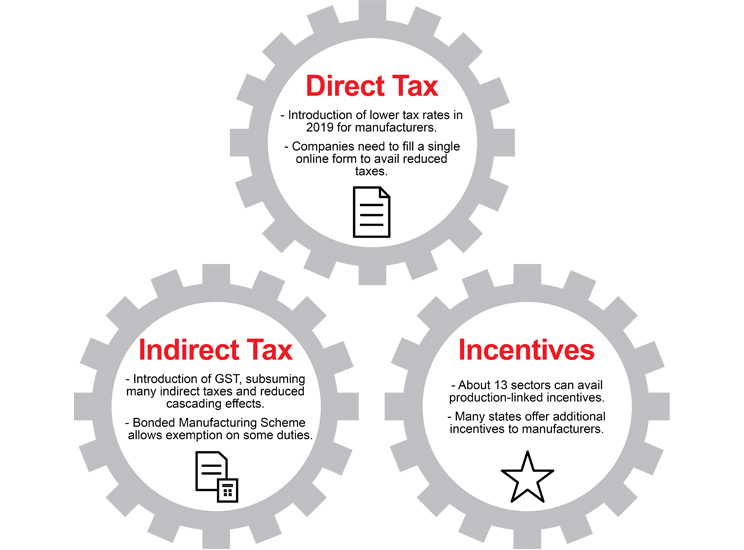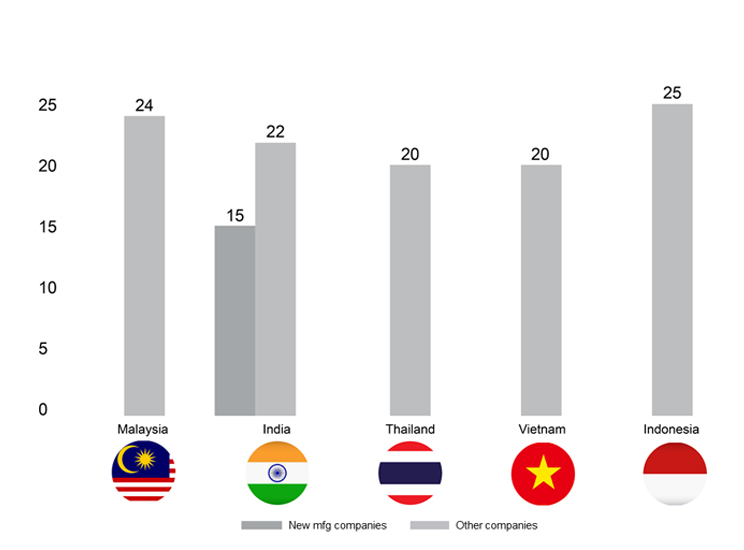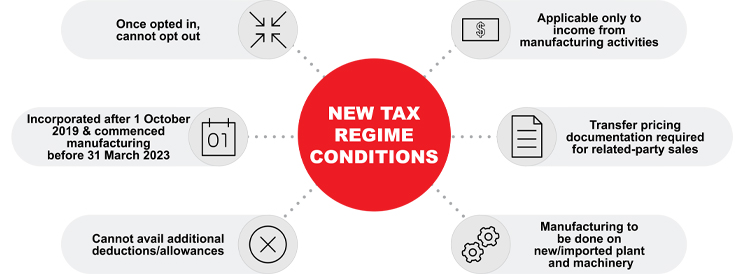Analyse: Leverage production-linked incentives & tax benefits
Integrated solutions to guide your manufacturing strategy from concept to operation
India’s manufacturing sector has attracted tremendous foreign investments since the introduction of new model of economic reforms in 1991: Liberalisation, Privatisation and Globalisation (LPG).
To further encourage economic development, the government of India has developed multi-fold policy changes to increase the ease of doing business in India.
Transformation under Government of India’s “Make in India” Campaign
Note: Direct tax is the applicable corporate tax rate on the profits generated from the business. Indirect tax is the Goods and Services Tax (GST) applicable on the supply of goods and services. Incentives are rebates and benefits that states and the Central government have introduced for investing in the country.
Direct Tax
- The current corporate tax rates applicable to domestic companies are between 25-30%, and to foreign companies, 40%.
- Introduction of multiple tax benefits and incentives to attract foreign investment in the manufacturing sector.
- Introduction of a new tax regime for domestic manufacturing companies in 2019: newly set-up manufacturing facilities are eligible to pay tax at a lower rate of 15% (excluding surcharge and cess).
Comparative Tax Rates* of India vs other MITI-V Countries
*The above rates exclude applicable surcharge and cess
- Companies can opt for the new tax regime by filing a one-page form when filing their first income tax return
Looking for more insights? Never miss an update.
The latest news, insights and opportunities from global commercial real estate markets straight to your inbox.
Conditions for Manufacturing Entities to Avail New Tax Regime
- Commencement of manufacturing activities will be considered when a company starts the commercial activity i.e., when manufacturing begins to generate revenues, sales, production expenses, etc.
- Even post commencement of manufacturing activities, companies continue to get tax benefits when they expand production facilities.
Tax rate on dividend distribution and royalty payment
- Dividend distribution by Indian companies is taxable to the recipient foreign investors. The rates depend on the applicable tax treaty. Typically, the treaty rates on dividend distributions are restricted to 10% or 15%, which are beneficial tax rates for foreign investors.
- Royalties payable by the manufacturing company to its parent are taxable from the parent company at the rate of 10% (plus applicable surcharge and cess). However, such tax is eligible for a foreign tax credit under the respective tax treaty in the parent company’s resident jurisdiction.
INDIRECT TAX
The most significant indirect tax reform was the introduction of GST (Goods and Services Tax, globally known as Value Added Tax or VAT). Various central and state taxes got subsumed in it.
Applicable taxes for a manufacturing entity and duty exemptions/benefits which a manufacturing entity can claim:
| Category | Type | Applicable Taxes | Duty Exemption |
|---|---|---|---|
| Procurement | Import of Capital goods | Custom duty & GST | Export promotion capital goods scheme |
| Import of raw materials/inputs | Advance authorisation | ||
| Import of services | GST | ||
| Import of purchase of goods | Deemed exports/merchant export benefits | ||
| Import of purchase of services | |||
| Supply | Domestic sales | GST | |
| Export of goods | No GST/GST* | Rebate of duties and taxes on exported products & GST refunds | |
| Export of services | GST Refunds |
*Under GST, there are two options available for exporting Goods/Services, i.e., Export of Goods/Services without payment of GST and with payment of GST.
Various other incentives and rebates are provided under indirect taxes to newly set up manufacturing facilities. Further, the benefits available under Foreign Trade Policy 2015-20 are extended for few schemes, which are subject to the introduction of the new Foreign Trade Policy.
The Customs duty and GST rates on procurement of goods are dependent upon Harmonized System of Nomenclature Codes (for goods) and Service Accounting Code (for services).
Although, the Customs duty rate ranges from 0% to 150%, most of the imported products have Customs duty rate of 7.5%, 10%, 15%. While the GST rate is generally defined as 0%, 5%, 12%, 18%, 28%, it is 18% on most goods and services.
There are a few Status-Holder schemes wherein the government offer duty exemptions.
- Special Economic Zone
- Export-Oriented Unit
- Bonded Warehouse (Manufacturing)
Under the bonded warehouse manufacturing scheme, introduced in 2019, the Customs duty and GST on imports can be deferred, subject to exports. A bonded warehouse can be set up anywhere across India and is recently attracting new manufacturing setups.
Customs Duty and GST exemptions for units operating under such schemes:
| Particulars | Special economic zone | Export oriented unit | Bonded warehouse |
|---|---|---|---|
| Import of goods | Custom duty & GST - Exempt | Custom duty & GST - Deferred | |
| Import of services | GST exempt only for authorised operations | GST payable | |
| Local purchase of goods/services | No GST | GST payable | |
| Export of goods | No duties | ||
| Domestic Supply of goods | Custom duty & GST on finishes goods | Custom duty on raw materials & GST on finishes goods | |
INCENTIVES
Central Government Incentives
The Central Government has introduced several incentive schemes to promote specific thrust sectors.
Production Linked Incentives (PLI) for 13 sectors (auto components, automobiles, aviation, chemicals, electronic schemes, food processing, medical devices, metal and mining, pharmaceuticals, renewal energy, telecom, textiles and white goods) for enhancing India’s manufacturing capabilities. These incentives are primarily offered as a percentage of the capital investment and linked to sales.
Moreover, the Central incentives are generally over and above the benefits states offer.
State Government Incentives
State incentives are availed by manufacturing entities engaged in eligible sectors/ product categories based on location and investment. Projects with a higher investment are typically provided with a customised package of incentives.
These are generally provided as:
- State GST reimbursement
- Capital investment subsidy
- Electricity duty exemption
- Stamp duty exemption
The percentage of benefits are generally based on capital investment and differ from state to state.
Benefits under the Foreign Direct Investment (FDI) rules
- The Government of India has now allowed 100% FDI under the automatic route in the manufacturing sector. Foreign investors do not need to approach the Reserve Bank of India (RBI) for obtaining multiple approvals to make investments in manufacturing companies.
- A company incorporated in India having foreign investment under the automatic route needs to now file online form(s) on the FIRMS (Foreign Investment Reporting and Management System) portal maintained by the RBI to report the status of its foreign investments.
Conclusion
It’s the best time to manufacture in India. Capital investment is encouraged at all levels of business, lower tax rates, central and state incentives, and easing of FDI norms.
Foreign companies wishing to invest in India can avail these benefits to set up a new manufacturing facility and take advantage of the vast consumer market with good economic prospects.
Coming up next (Article 3 of 6)
'Transact - Transactions Advisory'
Various options available and market trends in manufacturing
Business Enquiry:
Yogesh Shevade – Head, Logistics & Industrial, India, JLL
Author:
Chirag Shah – Founder, Transaction Square LLP
Acknowledgement:
JLL India would like to take this opportunity to thank Transaction Square, a Tax, Regulatory and Business Advisory firm with a pan India presence that is strategically focussed on transactions, including M&A advisory, restructuring, mergers, demergers, divestments, inbound and outbound investment advisory and post-deal support.
We would also like to acknowledge the strategic and critical data inputs from Abdul Barrister, Abhay Mundra, Sudeep Lalwani and Shreya Yeolekar.
Contact Yogesh Shevade
Head, Logistics & Industrial, India, JLLWhat’s your investment ambition?
Uncover opportunities and capital sources all over the world and discover how we can help you achieve your investment goals.



